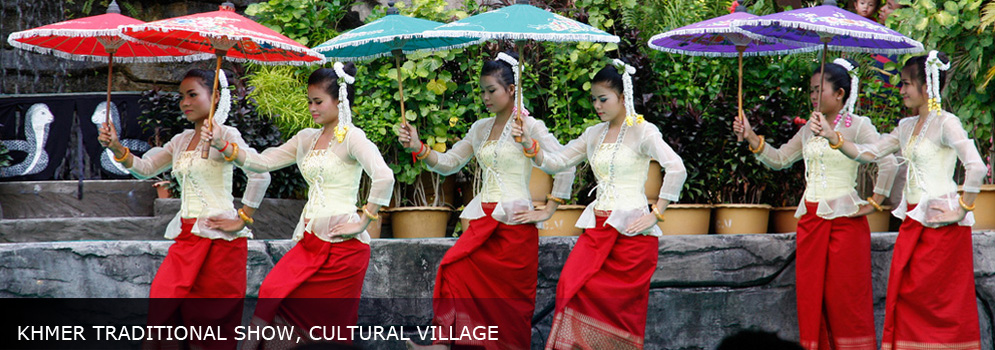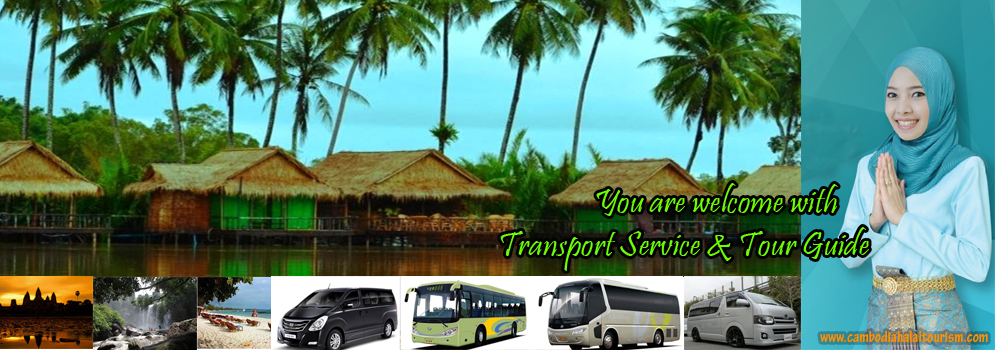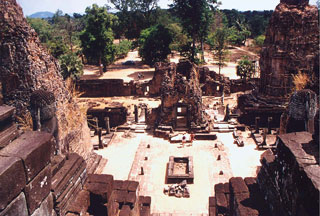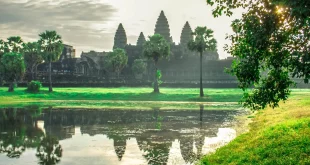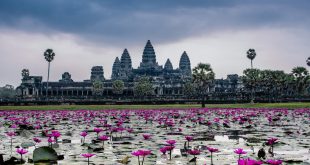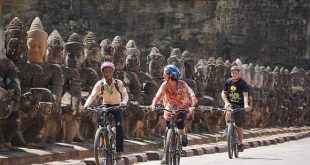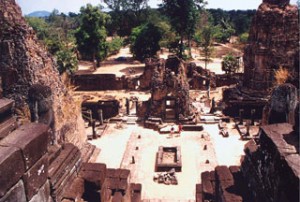
East Mebon How to go: Location: Description: Also built in the 10th Century by Rajendravarman, this temple was situated on a small island in the middle of the Oriental, or Eastern, Baray. It has all the characteristics of the mountain temple but was accessible by boat only. From the inscriptions found close to it, we know that Rajendravarman dedicated it to his parents.
East Mebon is a large temple-mountain-like ruin, rising three levels and crowned by five towers. Jayavarman IV, a usurper to the throne, moved the capital from Angkor to Koh Ker in 928AD. Sixteen years later Rajendravarman II returned the capital to Angkor and shortly thereafter constructed East Mebon on an island in the middle of the now dry Eastern Baray. The temple is dedicated to Shiva in honor of the king?s parents. Inscriptions indicate that it was also built to help reestablish the continuity of kingship at Angkor in light of the interruption that occurred when the seat of power had been moved to Koh Ker. There seems to be some scholarly debate as to whether East Mebon should be categorized as a temple-mountain. Inscriptions record activity at the temple as early as 947AD, but East Mebon was not consecrated until 952AD.
You need to use quite a bit of imagination when visiting the East Mebon temple. It’s not that the temple is badly ruined. The imagination is needed to think of the temple as it originally existed, as an island in the middle of a large artificial lake, the Eastern Baray.
When it was built, around 952, the East Mebon must have been quite impressive. The pyramidal structure consists of three concentric tiers crowned by five towers. It is a typical motif of many Angkor temples, which seek to represent Mount Meru, the location of the Hindu “heaven”. It must have been highly symbolic, rowing a boat across the lake to one of the temple’s four landings, then climbing up the tiers to pray at the shrines.
On arriving at the temple, one of the first things you’ll notice is are the large elephants standing at each corner of the lowest tier. The elephants are carved from a single block of stone. Gateways in the center of each side lead up to the second and third platforms.
It was realised during the reign of Yasovarman towards the end of the 9th century and supplied by waters from the Siem Reap river. This vast reservoir served to regulate the flow of the river and to irrigate the surrounding plain, is today given over to rice fields. To judge by the laterite steps that surround the small island of the Mebon, the original depth of water contained was approximately three metres and its volume must have been some 40 million cubic metres.
The Mebon has all the characteristics of a ‘temple-mountain’ symbolising Mount Meru – here there is a three-metre high central platform carrying the quincunx of towers. Originally the Mebon temple stood on an island surrounded entirely by the waters of the Eastern Baray – accessible only by boat. The centre of the baray was marked by this small island of 120 metres across on which the temple stands. The main entry pavilion of the Royal Palace and the Victory Gate of Angkor Thom were subsequently aligned along this axis.
Several inscriptions found in the vicinity as well as the foundation stele – dated 952 (only nine years prior to Pre- Rup) describe the placing in the various sanctuaries of the linga Sri Rajendresvara, of several gods – notably Shiva and Parvati “in the likeness of the mother and the father” of King Rajendravarman in addition to Vishnu with Brahma. Eight linga of the god in eight forms were also placed in the eight small towers of the surrounding court. The Mebon belongs to a group of temples consecrated to the memory of deified parents.
According to an inscription, the walls were originally covered externally with a lime-based plaster coating (as evident at Pre Rup temple) with the pitted hammer marks in the brickwork to adhere the stucco onto the towers, the only remaining evidence. Most lintels remain in place on this monument and are of excellent craftsmanship. On the central tower to the east, Indra on a three-headed elephant with flights of figures disgorged by makara, under a small frieze of figures in meditation; to the west, Skanda the god of war on his peacock with a line of figures holding lotus flowers; and to the south, Shiva on the sacred bull Nandin.
East Mebon, a 10th century Hindu temple, erected by Rajendravarman II, would have been on an islet in the centre of the Eastern Baray, but is now very much on dry land. This temple is like a smaller version of Pre Rup, which was built 15 to 20 years later and lies to the south. The temple-mountain form is topped off by the now familiar quincuncial arrangement of towers. The elaborate brick shrines are dotted with neatly arranged holes, which attached the original plasterwork. The base of the temple is guarded at its corners by perfectly carved stone figures of harnessed elephants, many of which are still in a very good state of preservation.
The East Mebon was built dedicated to the Hindu god of Shiva and honours the parents of the king. Its location reflects Khmer architects? concern with orientation and cardinal directions. It was built on a north-south axis with Rajendravarman?s state temple, Pre Rup, located about 1,200 meters to the south just outside the baray. The East Mebon also lies on an east-west axis with the palace temple Phimeanakas, another creation of Rajendravarman?s reign, located about 6,800 meters due west.
It has two enclosing walls and three tiers. It includes the full array of durable Khmer construction materials: sandstone, brick, laterite and stucco. At the top is a central tower on a square platform, surrounded by four smaller towers at the platform?s corners. The towers are of brick; holes that formerly anchored stucco are visible.
The sculpture at the East Mebon is varied and exceptional, including two-meter-high free-standing stone elephants at corners of the first and second tiers. Religious scenes include the god Indra atop his three-headed elephant Airavata, and Shiva on his mount, the sacred bull Nandi. Carving on lintels is particularly elegant.
East Mebon is a small temple built in the reign of king Rajendravarman, who named the temple ‘Yashodharatataka’ (the reservoir of Yashodhara). King Rajendravarman greatly admired King Yashovarman I, who ruled from 889-900 AD and built the East Baray (reservoir). Out of respect, King Rajendravarman built East Mebon at the center of the baray. Its main god was Rajendreshvara, a linga of the present king.
The lovely temple of Mebon, a pyramid of receding terraces on which are placed many detached edifices, the most effective being the five towers which crown the top Could any conception be lovelier, a vast expanse of sky-tinted water as wetting for a perfectly ordered temple. The East Mebon is 500metre (1,640feet) north of Pre Rup. A enter and leave the temple from the east entrance. It was built in the second half of the tenth century (952) by king Rajendravarman II, dedicated to Siva (Hindu), an ancestor temple in memory of the parents of the king with following the Pre Rup style art.
The Mebon stands on a small island in the middle of the Eastern Baray, which was a large body of water (2 by 7 kilometres, 1.2by4.3miles) fed by the Siem Reap River. The temple was accessible only by boat. Today the baray, once a source of water for irrigation, is a plain of rice fields and the visitor is left to imagine the original majesty of this temple in the middle of a large lake.
The East Mebon is a temple with five towers arranged like the numbers on a die atop a base with three tiers. The whole is surrounded by three enclosures. The towers represent the five peaks of the mythical Mount Meru.
The stairways of the tiered base are flanked by lions (6). Beautiful monolithic elephants stand majestically at the corners of the first and second tiers (7). They are depicted naturalistically with fine detail such as harnessing. Tip: The elephant in the best condition, and the most complete, is in the southwest corner.
The large inner courtyard contains eight small brick towers (8)-two on each side opening to the East. Each one has octagonal columns and finely worked lintels with figures amongst leaf decorations. On the East Side of the courtyard there are three rectangular laterite buildings (9) without windows opening to the west. The two on the left of the entrance are decorated with either scenes of the stories of the nine planets or the seven ascetics. Vestiges of bricks above the cornices suggest they were vaulted. There are two more buildings (without windows) of similar form at the northwest and southwest (9) comers of the courtyard.
